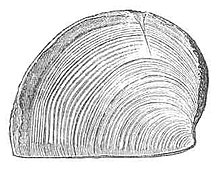| Trigonellites Temporal range: Late Jurassic,
~ | |
|---|---|

| |
| 1895 drawing of an aptychi of T. latus | |
| Scientific classification | |
| Domain: | Eukaryota |
| Kingdom: | Animalia |
| Phylum: | Mollusca |
| Class: | Cephalopoda |
| Subclass: | †Ammonoidea |
| Genus: | †Trigonellites Parkinson, 1811 |
| Type species | |
| †Trigonellites latus Parkinson, 1811
| |
| Other species | |
| |
| Synonyms | |
Trigonellites is an extinct genus of basal ammonite, known from two or three species, discovered in outcrops of the Late Jurassic-aged Kimmeridge Clay Formation in Ely and Cumnor, England and possibly also an unnamed Early Triassic-aged rock formation in Bindlach, Germany.[2] It was originally classified as a bivalve,[1] but it has since been classed as an ammonite species. Only two species once placed in the genus are still considered valid today: T. latus and T. curvirostris, with one dubious species, T. simplex, possibly being a species of Lyrodon.[1]
The genus name Trigonellites was originally proposed for some calcareous plates found in Cretaceous oolitic rocks, but these have since been declassed as indeterminate ammonites as the name was never published. The name has since been used to represent two species of Late Jurassic (c.156-151 Ma) ammonites and one Early Triassic (c.242.7 Ma) species.[1]
References[edit]
- ^ a b c d G. A. Goldfuss. (1863). Abbildungen und Beschreibungen der Petrefacten Deutschlands und der angrenzenden Länder. Divisio Quarta: Molluscorum acephalicorum reliquiae. Muschelthiere der Vorwelt. 1. Bivalvia. Petrefacta Germaniae 4(1):1-273
- ^ J. Prestwich. (1879). On the discovery of a species of Iguanodon in the Kimmeridge Clay near Oxford; and a notice of a very fossiliferous band of the Shotover Sands. Geological Magazine, new series, decade 2 6(5):193-195
Well, that’s interesting to know that Psilotum nudum are known as whisk ferns. Psilotum nudum is the commoner species of the two. While the P. flaccidum is a rare species and is found in the tropical islands. Both the species are usually epiphytic in habit and grow upon tree ferns. These species may also be terrestrial and grow in humus or in the crevices of the rocks.
View the detailed Guide of Psilotum nudum: Detailed Study Of Psilotum Nudum (Whisk Fern), Classification, Anatomy, Reproduction